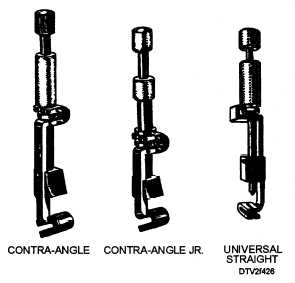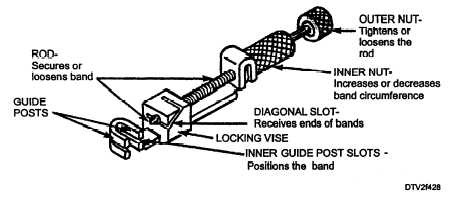
Figure 4-26. - Matrix retainers.

Figure 4-27. - Amalgam matrix bands. A: Precontoured. B: Junior (Pedodontic #15 with aprons). C: Wide #2 with aprons. D: Junior #13 (Pedodontic). E: Universal #1.
Amalgam Matrices
Amalgam matrices are made of very thin flexible stainless steel available in either roll form or in bands. At times, the standard packaged matrix bands do not provide the necessary length, width, or shape for a particular cavity preparation. When this is the case, the dentist can cut the metal matrix strips to form the needed band. Bands used with the Tofflemire retainers completely encircle the tooth. Matrix bands come in assorted sizes and shapes, as shown in figure 4-27. The
most commonly used band is the Universal or Straight #1 size. The Junior #13 is the smaller pedodontic version of the #1 Universal. The Wide #2 and Junior #15, (which have extensions known as “aprons”) are used when additional length is needed for a preparation extending below the gingiva. A dentist usually prefers certain types of these bands over others. With practice, you should become very proficient in having the preferred band on the appropriate retainer.
ASSEMBLING MATRICES
When multiple surfaces of the tooth are removed during the cavity preparation, a matrix is used to approximate the original surface and hold the restorative material in proper form and position until it sets. The type of matrices used depends on the type of restorative material placed. You will need to have the right type of matrix available and assembled ready for use during the procedure.
Amalgam matrices are made of very thin, flexible stainless steel available in either roll form or bands. The matrix band, retainer, and wedge are used in combination to form a temporary mold while the filling material is being packed.
The matrix is assembled and placed before the amalgam is mixed. After the amalgam has been packed, the matrix and wedge must be removed before the final carving can be accomplished.
The most commonly used retainer is the universal straight Tofflemire. Its components are shown in figure 4-28.

Figure 4-28. - Components of the matrix retainer.
Continue Reading